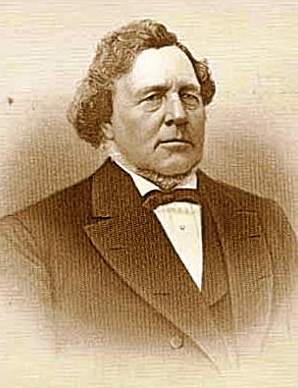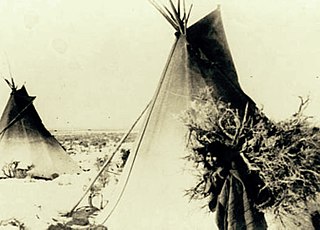
Brigham Young was an American religious leader and politician. He was the second president of the Church of Jesus Christ of Latter-day Saints from 1847 until his death in 1877. During his time as church president, Young led his followers, the Mormon pioneers, west from Nauvoo, Illinois, to the Salt Lake Valley. He founded Salt Lake City and served as the first governor of the Utah Territory. Young also worked to establish the learning institutions that would later become the University of Utah and Brigham Young University. A polygamist, Young had at least 56 wives and 57 children. He formalized the prohibition of black men attaining priesthood, and led the church in the Utah War against the United States.
Antonga, or Black Hawk, was a nineteenth-century war chief of the Timpanogos Tribe in what is the present-day state of Utah. He led the Timpanogos against Mormon settlers and gained alliances with Paiute and Navajo bands in the territory against them during what became known as the Black Hawk War in Utah (1865–1872). Although Black Hawk made peace in 1867, other bands continued raiding until the US intervened with about 200 troops in 1872. Black Hawk died in 1870 from a gunshot wound he received while trying to rescue a fallen warrior, White Horse, at Gravely Ford Richfield, Utah, June 10, 1866. The wound never healed and complications set in.

George Albert Smith was an early leader in the Latter Day Saint movement. He served in the Quorum of the Twelve Apostles and as a member of the First Presidency of the Church of Jesus Christ of Latter-day Saints.
Chief Walkara was a Shoshone leader of the Utah Indians known as the Timpanogo and Sanpete Band. It is not completely clear what cultural group the Utah or Timpanogo Indians belonged to, but they are listed as Shoshone. He had a reputation as a diplomat, horseman and warrior, and a military leader of raiding parties, and in the Wakara War.

Jacob Hamblin was a Western pioneer, a missionary for the Church of Jesus Christ of Latter-day Saints, and a diplomat to various Native American tribes of the Southwest and Great Basin. He aided European-American settlement of large areas of southern Utah and northern Arizona, where he was seen as an honest broker between Latter-day Saint settlers and the Natives. He is sometimes referred to as the "Buckskin Apostle", or the "Apostle to the Lamanites". In 1958, he was inducted into the Hall of Great Westerners of the National Cowboy & Western Heritage Museum.

The History of Utah is an examination of the human history and social activity within the state of Utah located in the western United States.

The Black Hawk War, or Black Hawk's War, is the name of the estimated 150 battles, skirmishes, raids, and military engagements taking place from 1865 to 1872, primarily between Mormon settlers in Sanpete County, Sevier County and other parts of central and southern Utah, and members of 16 Ute, Southern Paiute, Apache and Navajo tribes, led by a local Ute war chief, Antonga Black Hawk. The conflict resulted in the abandonment of some settlements and hindered Mormon expansion in the region.
The Mountain Meadows Massacre was caused in part by events relating to the Utah War, an armed confrontation in Utah Territory between the United States Army and Mormon Settlers. In the summer of 1857, however, Mormons experienced a wave of war hysteria, expecting an all-out invasion of apocalyptic significance. From July to September 1857, Mormon leaders prepared Mormons for a seven-year siege predicted by Brigham Young. Mormons were to stockpile grain, and were prevented from selling grain to emigrants for use as cattle feed. As far-off Mormon colonies retreated, Parowan and Cedar City became isolated and vulnerable outposts. Brigham Young sought to enlist the help of Indian tribes in fighting the "Americans", encouraging them to steal cattle from emigrant trains, and to join Mormons in fighting the approaching army.
The conspiracy and siege of the Mountain Meadows Massacre was initially planned by its Mormon perpetrators to be a short "Indian" attack, against the Baker–Fancher party. But the planned attack was repulsed and soon turned into a siege, which later culminated in the massacre of the remaining emigrants, on September 11, 1857.

The Pahvant or Pahvants were a band of Ute people that lived in present-day Utah. Called the "Water People", they fished and hunted waterfowl. They were also farmers and hunter-gatherers. In the 18th century they were known to be friendly and attentive, but after a chief's father was killed by emigrating white settlers, a group of Pahvant Utes killed John Williams Gunnison and seven of his men during his exploration of the area. The bodies of water of their homeland were dried up after Mormons had diverted the water for irrigation. Having intermarried with the Paiutes, they were absorbed into the Paiute Indian Tribe of Utah and relocated to reservations.

During and after the European colonization of the Americas, European settlers practiced widespread enslavement of Indigenous peoples. In the 15th Century, the Spanish introduced chattel slavery through warfare and the cooption of existing systems. A number of other European powers followed suit, and from the 15th through the 19th centuries, between two and five million Indigenous people were enslaved, which had a devastating impact on many Indigenous societies, contributing to the overwhelming population decline of Indigenous peoples in the Americas.

The Act in Relation to Service, which was passed on Feb 4, 1852 in the Utah Territory, made slavery legal in the territory. A similar law, Act for the relief of Indian Slaves and Prisoners was passed on March 7, 1852, and specifically dealt with Indian slavery.
The Battle at Fort Utah was a violent attack in 1850 in which 90 Mormon militiamen surrounded an encampment of Timpanogos families on the Provo River one winter morning, and laid siege for two days, eventually shooting between 40 and 100 Native American men and one woman with guns and a cannon during the attack as well as during the pursuit and capture of the two groups that fled the last night. One militiaman died from return fire during the siege. Of the Timpanogos people who fled in the night, one group escaped southward, and the other ran east to Rock Canyon. Both groups were captured, however, and the men were executed. Over 40 Timpanogos children, women, and a few men were taken as prisoners to nearby Fort Utah. They were later taken northward to the Salt Lake Valley and sold as slaves to church members there. The bodies of up to 50 Timpanogos men were beheaded by some of the settlers and their heads put on display at the fort as a warning to the mostly women and children prisoners inside.

Chief Peteetneet, or more precisely Pah-ti't-ni't, was a clan leader of a band of Timpanogos that lived near Peteetneet Creek, which was named for him, in what is now known as Payson, Utah, United States.

The Act for the relief of Indian Slaves and Prisoners, which was passed on March 7, 1852 in the Utah Territory, dealt with Indian slavery. A similar law, the Act in Relation to Service, which had made slavery legal in the territory, had been passed on February 4, 1852.

The Latter Day Saint movement has had varying and conflicting teachings on slavery. Early converts were initially from the Northern United States and opposed slavery, believing that their opposition was supported by Mormon scripture. After the church base moved to the slave state of Missouri and gained Southern converts, church leaders began to enslave people. New scriptures instructing Latter-Day Saints not to intervene in the lives of the enslaved people were revealed. A few enslavers joined the church, and when they moved to Nauvoo, Illinois, they illegally took their enslaved people with them, even though Illinois was a free state.
Civil rights and Mormonism have been intertwined since the religion's start, with founder Joseph Smith writing on slavery in 1836. Initial Mormon converts were from the north of the United States and opposed slavery. This caused contention in the slave state of Missouri, and the church began distancing itself from abolitionism and justifying slavery based on the Bible. During this time, several slave owners joined the church, and brought their enslaved people with them when they moved to Nauvoo, Illinois. The church adopted scriptures which teach against influencing slaves to be "dissatisfied with their condition" as well as scriptures which teach that "all are alike unto God." As mayor of Nauvoo, Smith prohibited Black people from holding office, joining the Nauvoo Legion, voting or marrying whites; but, as president of the church Black people became members and several Black men were ordained to the priesthood. Also during this time, Smith began his presidential campaign on a platform for the government to buy slaves into freedom over several years. He was killed during his presidential campaign.
Wakara's War, also known as Walker's War was a dispute between the Paiute Indians and the Mormon settlers in the Utah Valley. This war is characterized as a string of disputes and skirmishes over property and the land from July 1853 to May 1854. This war was influenced by factors such as religious differences, the slave trade, and the division of the Salt Lake Valley.

Over the past two centuries, the relationship between Native American people and Mormonism has included friendly ties, displacement, battles, slavery, education placement programs, and official and unofficial discrimination. Native American people were historically considered a special group by adherents of the Latter Day Saint movement (Mormons) since they were believed to be the descendants of the Lamanite people described in The Book of Mormon. There is no support from genetic studies and archaeology for the historicity of the Book of Mormon or Middle Eastern origins for any Native American peoples. Today there are many Native American members of Mormon denominations as well as many people who are critical of Mormonism and its teachings and actions around Native American people.

Hark Lay Wales, born in Monroe County Mississippi, was one of the few African Americans to cross the Mormon Trail as a pioneer with members of The Church of Jesus Christ of Latter-day Saints. Hark Lay Wales was a hardworking man who helped the Saints cross the Mormon Trail and arrive in Utah. He acquired his freedom and lived a peaceful life in California until he later returned to Utah. Not much is known about the life of Hark Lay Wales but he was a historic figure for the history of African Americans in the Church of Jesus Christ of Latter-Day Saints.











